哈希(1)
回顾概念
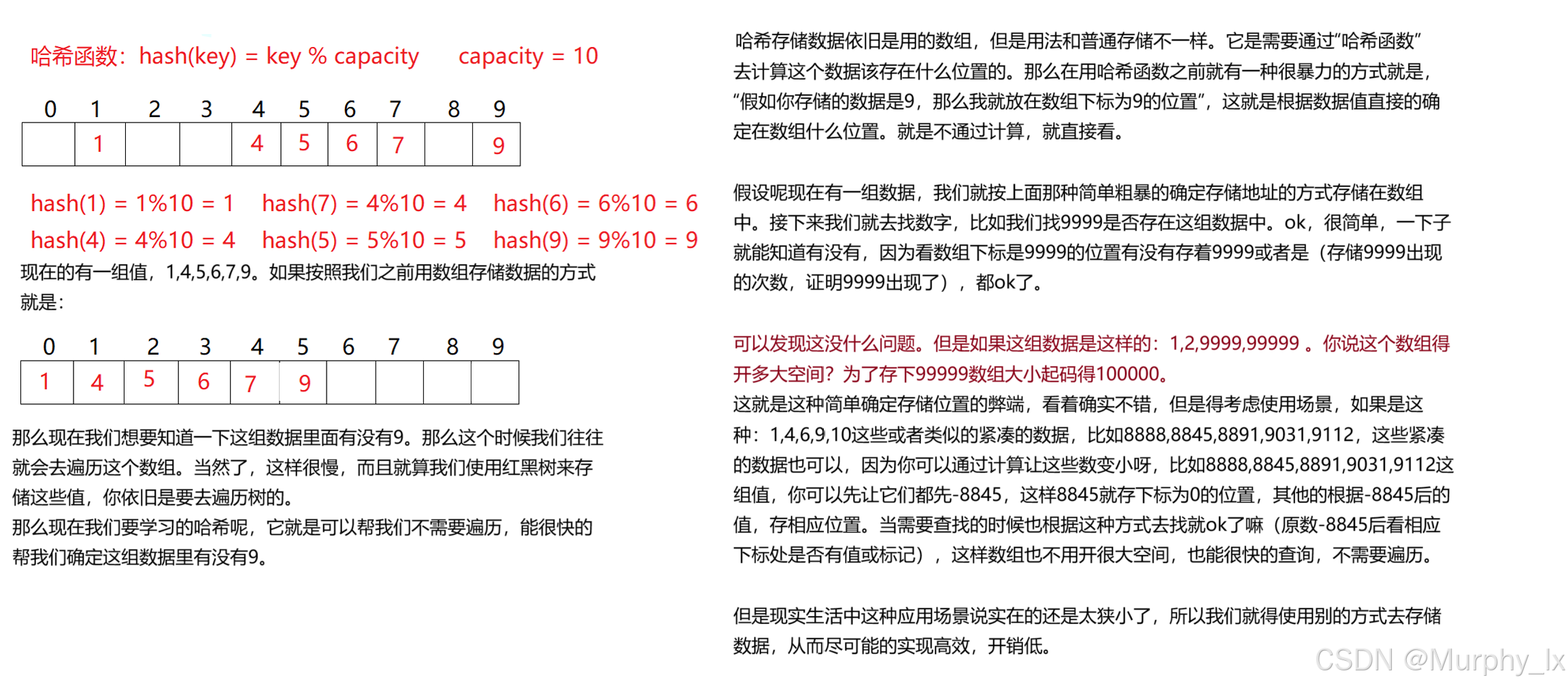
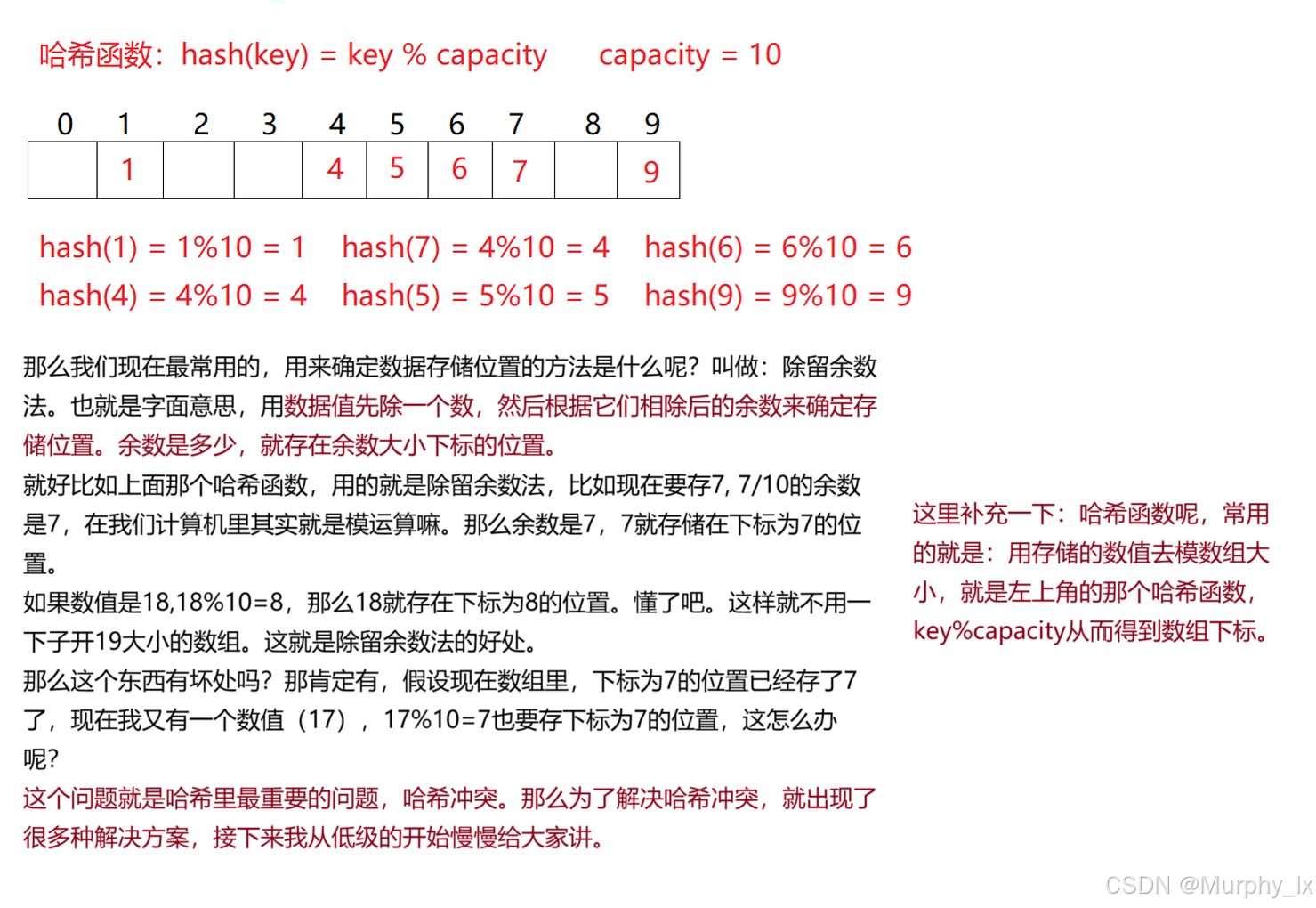
哈希冲突处理方法(低级)
1. 闭散列
闭散列:也叫开放定址法,当发生哈希冲突时,如果哈希表未被装满,说明在哈希表中必然还有空位置,那么可以把key存放到冲突位置中的“下一个” 空位置中去。那如何寻找下一个空位置呢?
1. 线性探测
线性探测:从发生冲突的位置开始,依次向后探测,直到寻找到下一个空位置为止。
- 插入:
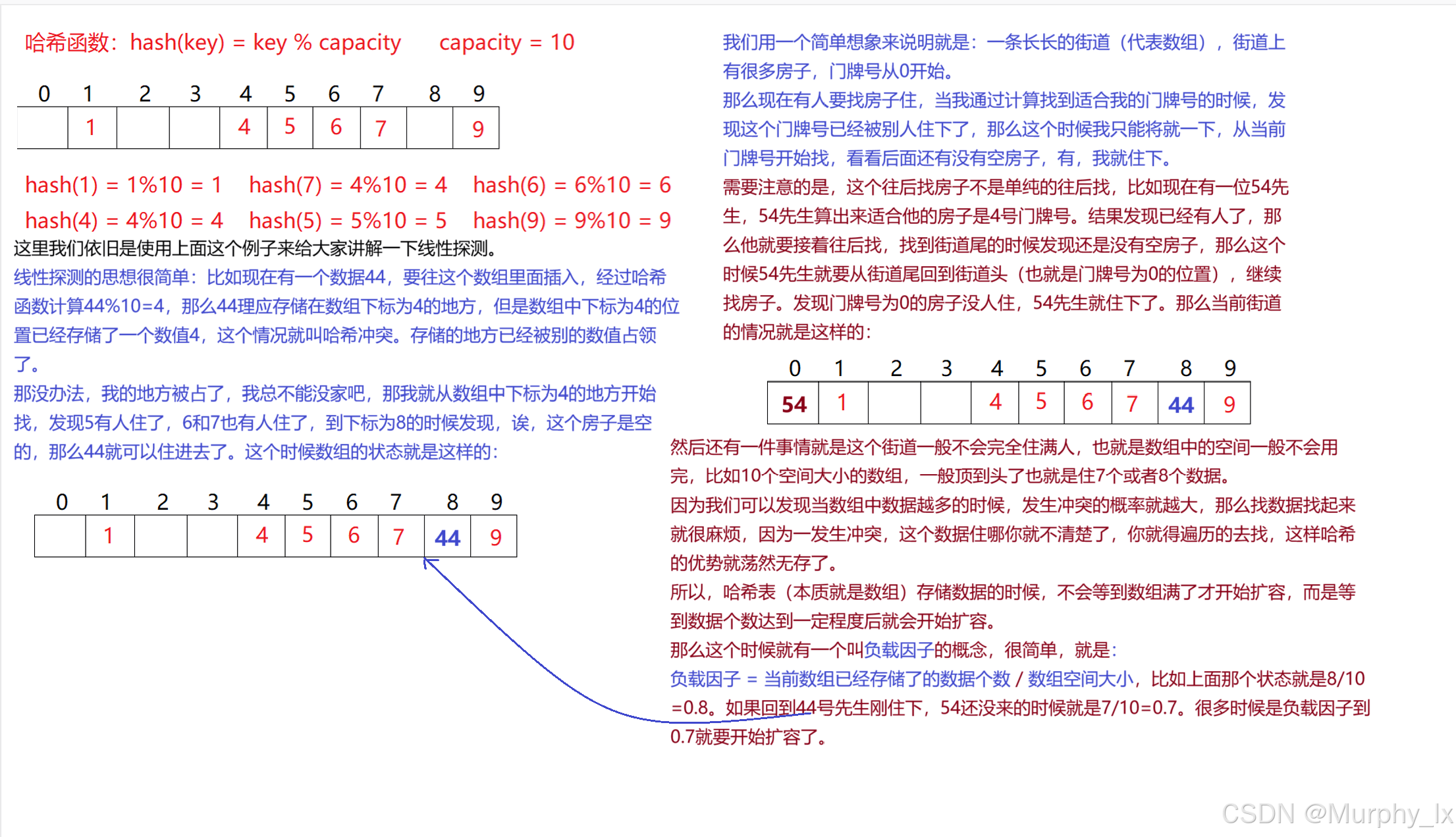
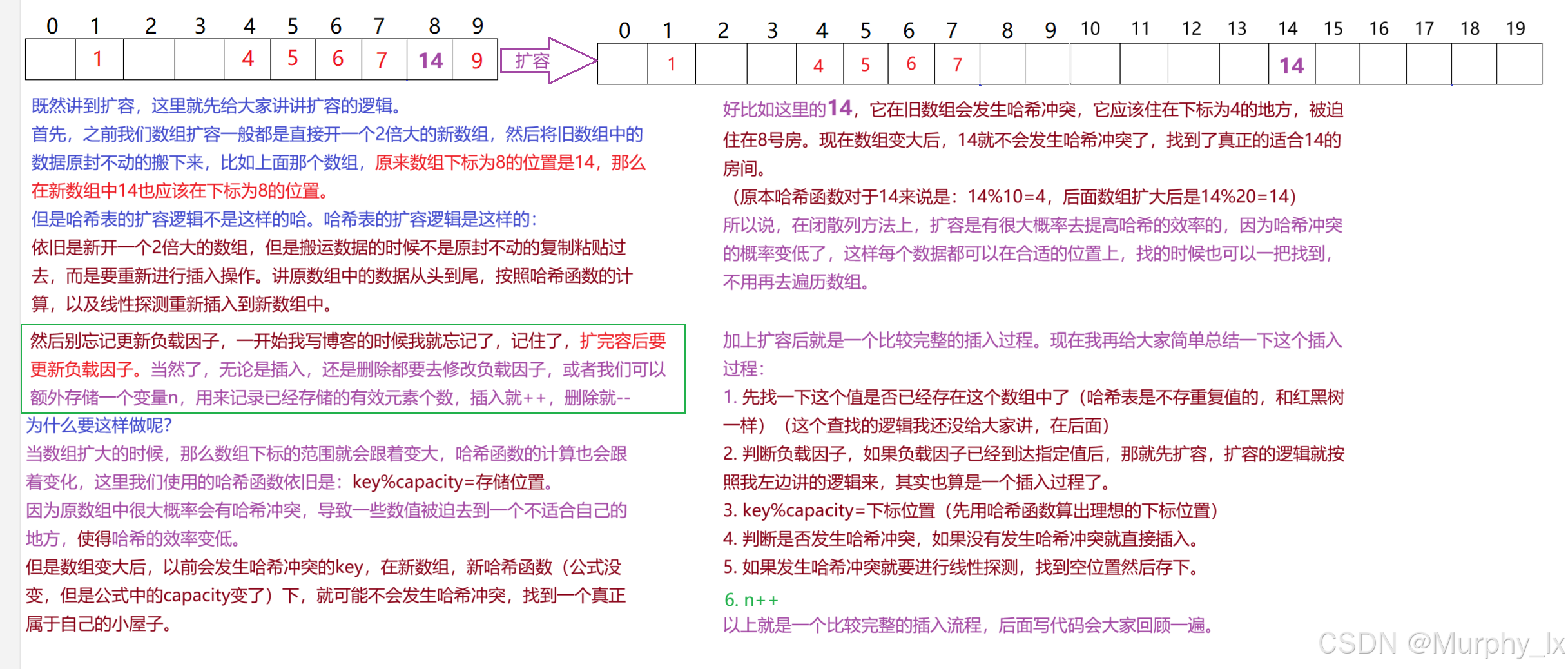
- 查找:
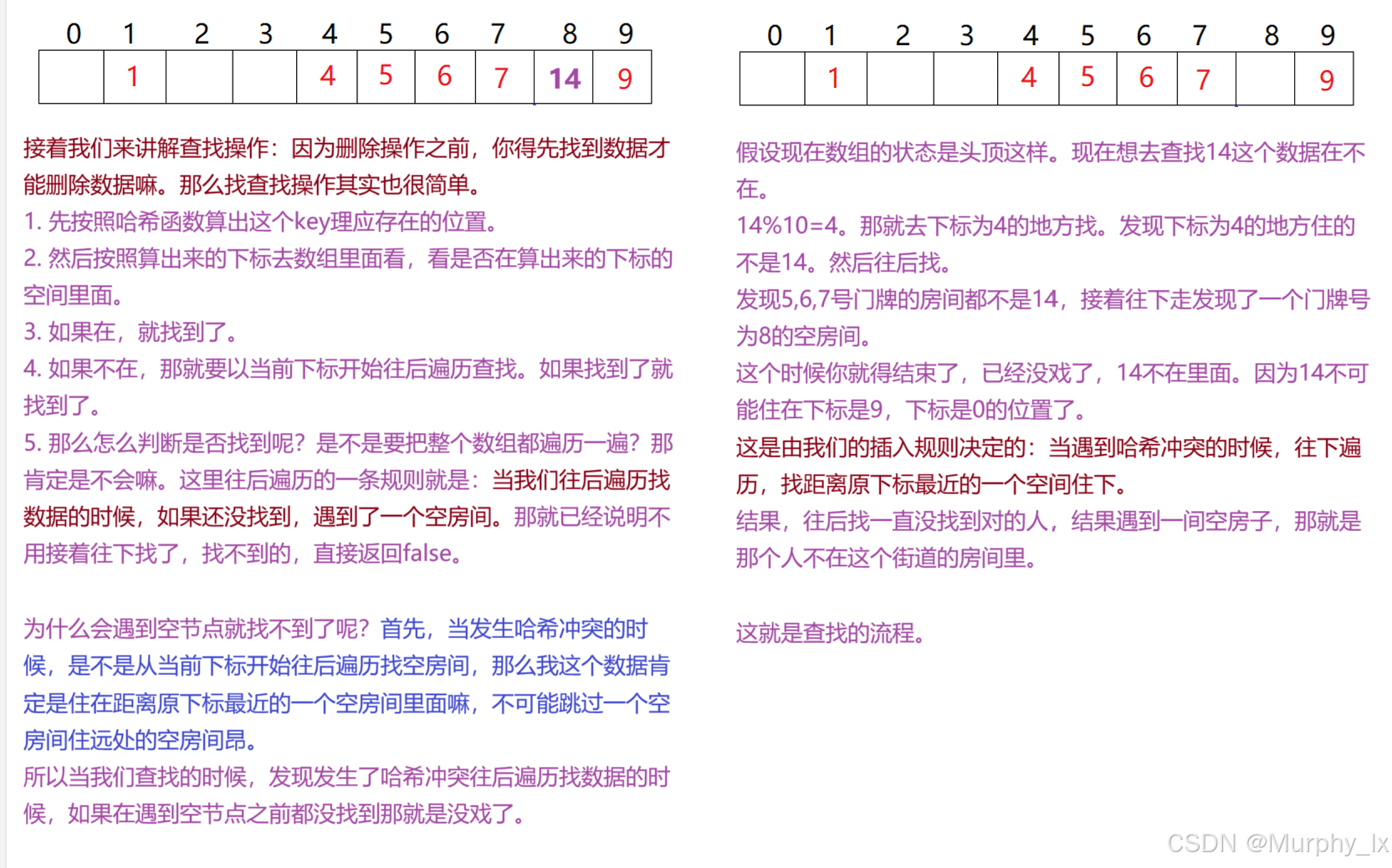
- 删除:
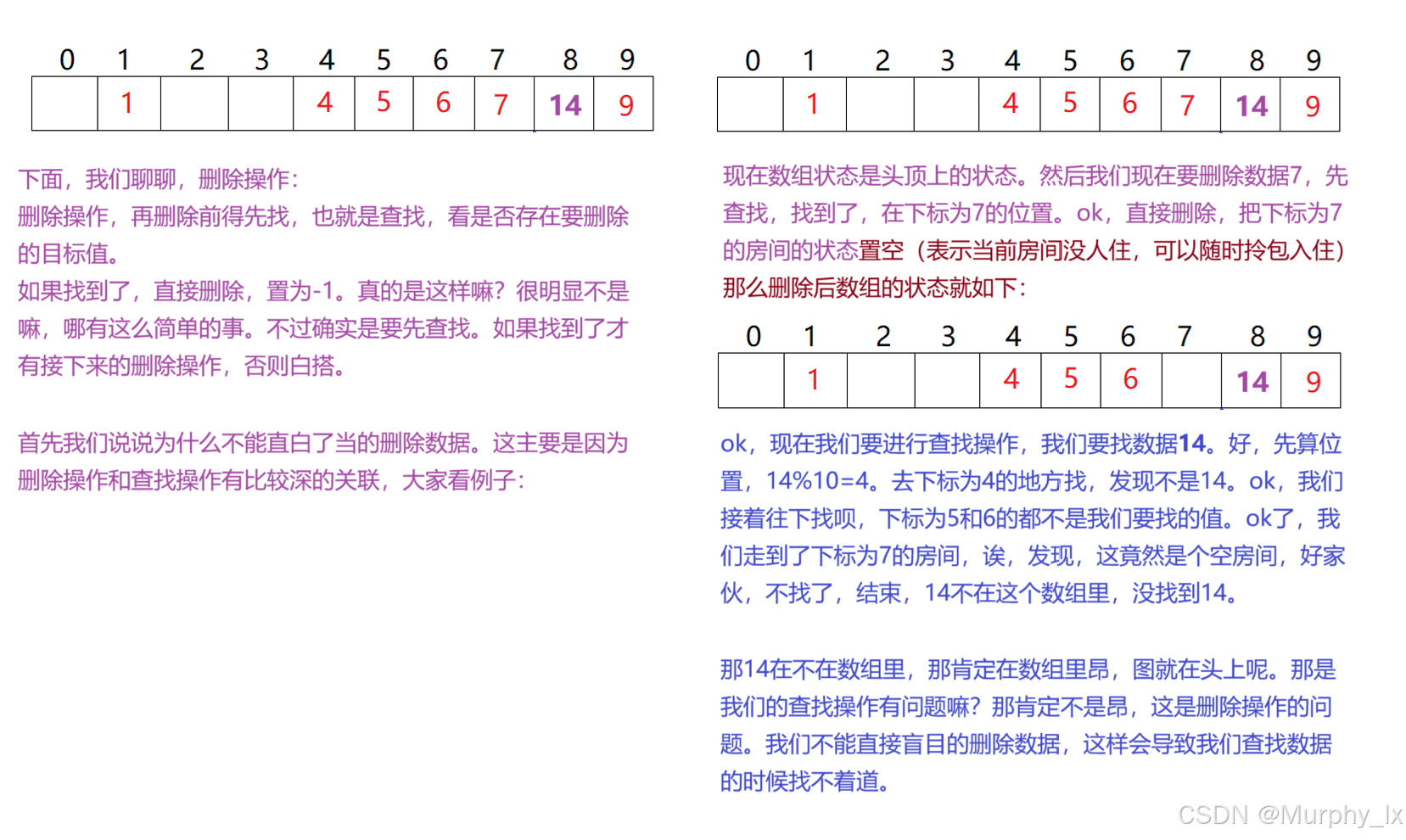
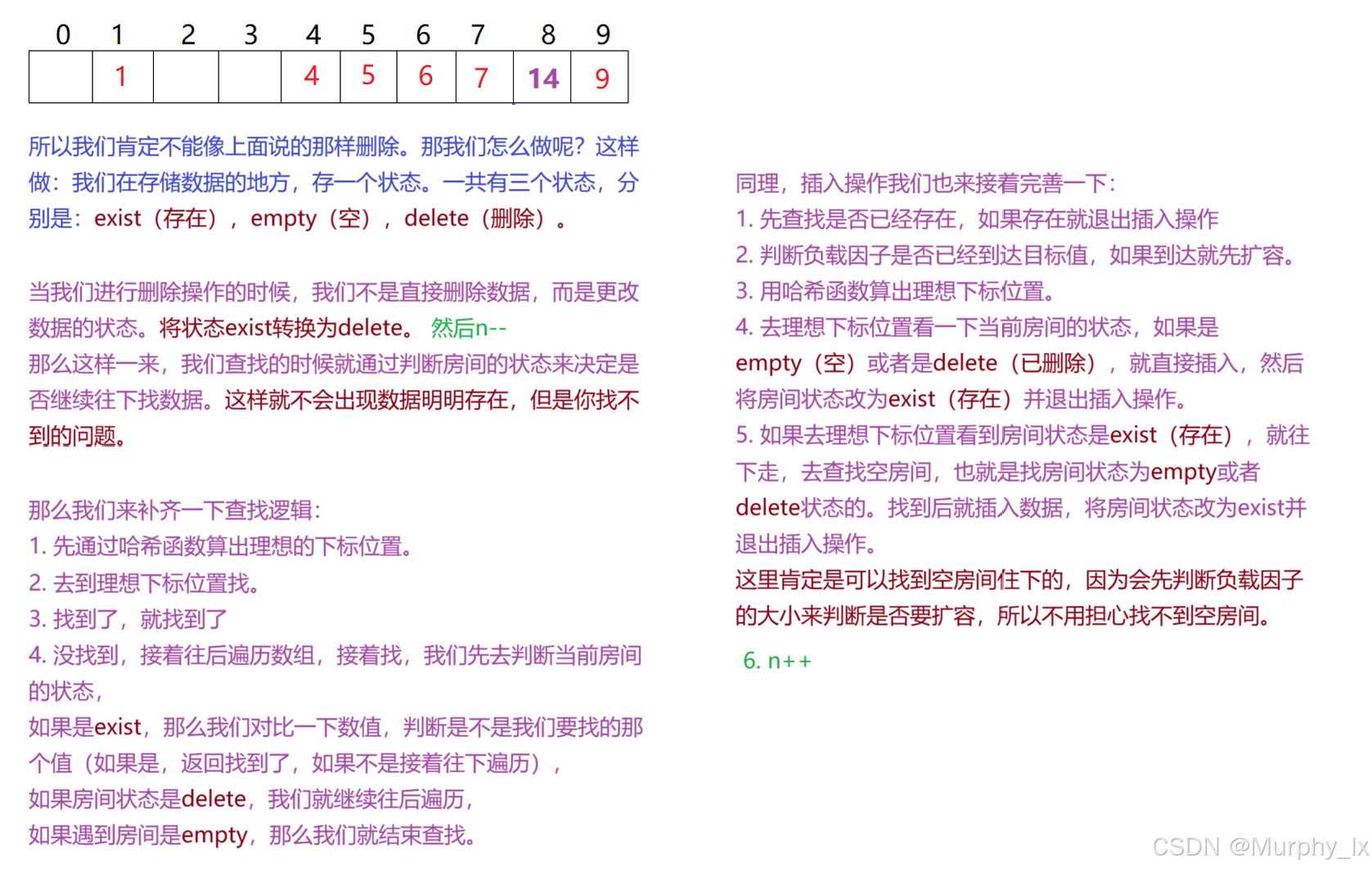
讲清楚规则之后,我们就开始写代码:
完整代码
Hash.h
#pragma once
#include<iostream>
#include<cassert>
#include<utility>
#include<vector>
using namespace std;
enum State
{
EMPTY,
EXIST,
DELETE
};
template<class K, class V>
struct HashData
{
pair<K, V> _data;
State _state = EMPTY;
};
template<class K, class V>
class HashTables
{
public:
HashTables(size_t size = 10)
{
_Table.resize(size);
}
HashData<K, V>* find(const K& key);
bool insert(const pair<K, V>& data);
bool erase(const K& key);
private:
vector<HashData<K, V>> _Table;
size_t _n = 0;//存储已有数据个数
};
template<class K, class V>
HashData<K, V>* HashTables<K, V>::find(const K& key)
{
//先用哈希函数算位置
size_t Hash_i = key % _Table.size();
//判断是否理想下标处是否是目标值
while (_Table[Hash_i]._state != EMPTY)
{
if (_Table[Hash_i]._state == EXIST && _Table[Hash_i]._data.first == key)
{
return &_Table[Hash_i];
}
++Hash_i;
/*if (Hash_i >= _Table.size())
{
Hash_i = 0;
}*/
Hash_i %= _Table.size();
}
return nullptr;
}
template<class K, class V>
bool HashTables<K, V>::insert(const pair<K, V>& data)
{
//先判断新数据是否是重复值
if (find(data.first) != nullptr)
{
return false;
}
//然后计算负载因子,判断是否扩容
double LoadFactor = (double)_n / (double)_Table.size();
if (LoadFactor >= 0.7)
{
//扩容
size_t newsize = _Table.size() * 2;
//用newsize创建一个新的哈希表对象
HashTables<K, V> newtable(newsize);
for (const auto& e : _Table)
{
if (e._state == EXIST)
{
newtable.insert(e._data);
}
}
_Table.swap(newtable._Table);
}
size_t Hash_i = data.first % _Table.size();
while (_Table[Hash_i]._state == EXIST)
{
++Hash_i;
/*if (Hash_i >= _Table.size())
{
Hash_i = 0;
}*/
Hash_i %= _Table.size();
}
_Table[Hash_i]._data = data;
_Table[Hash_i]._state = EXIST;
_n++;
return true;
}
template<class K, class V>
bool HashTables<K, V>::erase(const K& key)
{
HashData<K, V>* ret = find(key);
if (ret == nullptr)
{
return false;
}
ret->_state = DELETE;
_n--;
return true;
}
test.cpp
#include"Hash.h"
void test1()
{
HashTables<int, int> ht;
ht.insert(make_pair(23, 1));
ht.insert(make_pair(45, 1));
ht.insert(make_pair(78, 1));
ht.insert(make_pair(12, 1));
ht.insert(make_pair(67, 1));
ht.insert(make_pair(89, 1));
ht.insert(make_pair(3, 1));
ht.insert(make_pair(56, 1));
ht.insert(make_pair(92, 1));
ht.insert(make_pair(19, 1));
ht.erase(23);
//ht.insert(make_pair(43,1));
HashData<int, int>* rt = ht.find(3);
ht.erase(45);
ht.erase(78);
}
int main()
{
test1();//这里大家可以用vs的监视窗口来验证正确与否
return 0;
}
- 结构
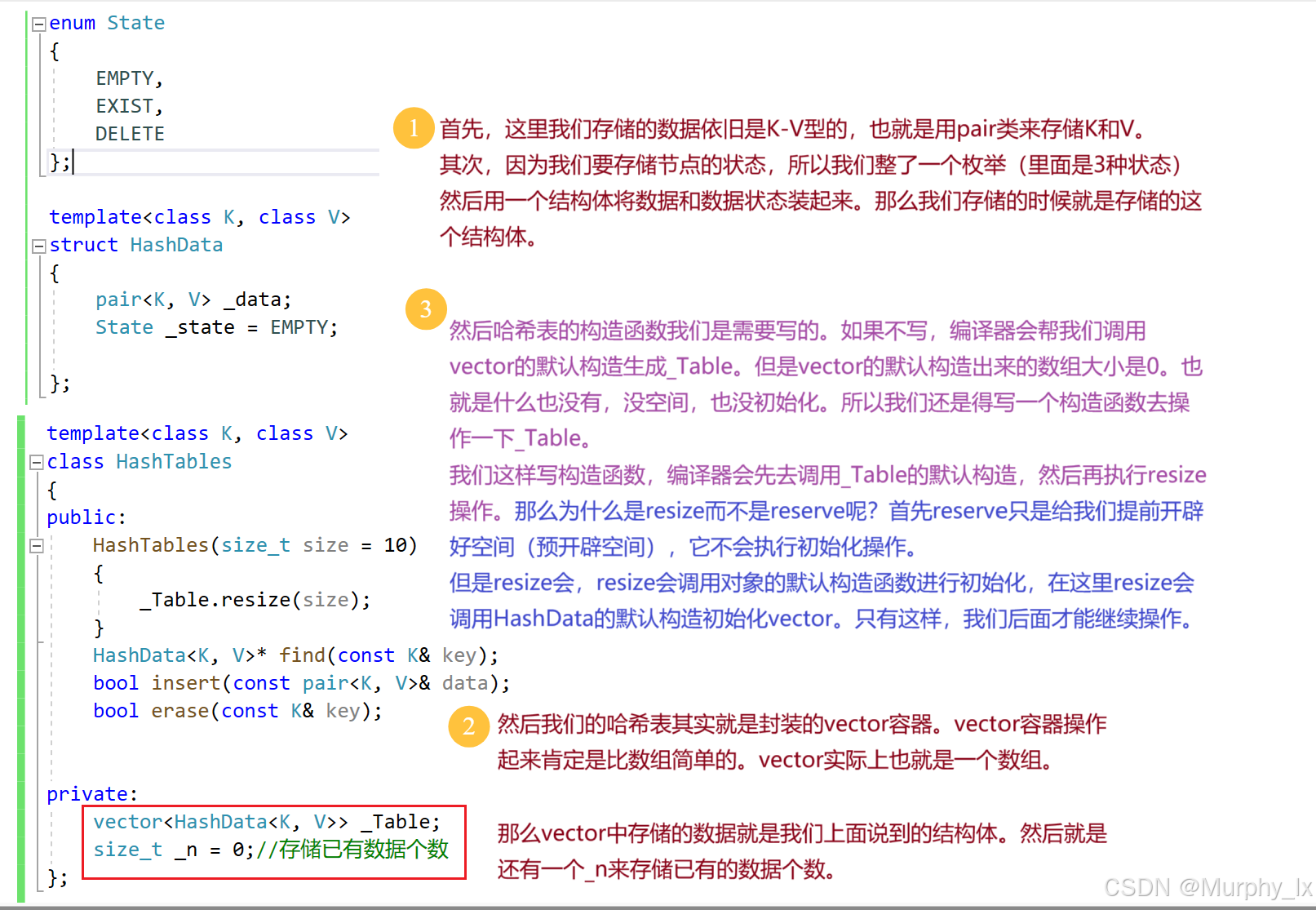
vector 中 resize() 和 reserve() 的区别图示
文字图示比较
初始状态:
vector<int> vec;
+-----------------+
| size: 0 |
| capacity: 0 |
| 元素: 无 |
+-----------------+
调用 vec.reserve(5) 后:
+-----------------+
| size: 0 | ← 大小不变
| capacity: 5 | ← 容量增加
| 元素: [?, ?, ?, ?, ?] ← 内存已分配但未初始化
+-----------------+
调用 vec.resize(3) 后:
+-----------------+
| size: 3 | ← 大小增加
| capacity: 5 | ← 容量不变(已有足够空间)
| 元素: [0, 0, 0] | ← 新元素被初始化为默认值(0)
+-----------------+
调用 vec.resize(5, 42) 后:
+-----------------+
| size: 5 | ← 大小增加
| capacity: 5 | ← 容量不变
| 元素: [0, 0, 0, 42, 42] ← 新元素被初始化为指定值(42)
+-----------------+
调用 vec.reserve(10) 后:
+-----------------+
| size: 5 | ← 大小不变
| capacity: 10 | ← 容量增加
| 元素: [0, 0, 0, 42, 42, ?, ?, ?, ?, ?] ← 原有元素保留,新增空间未初始化
+-----------------+
可视化图表
reserve(n) 操作:
+---+---+---+---+---+---+---+---+---+---+
| | | | | | | | | | | ← 分配内存但不初始化
+---+---+---+---+---+---+---+---+---+---+
↑ ↑
容量增加 大小不变
resize(n) 操作:
+---+---+---+---+---+---+---+---+---+---+
| 0 | 0 | 0 | 0 | 0 | | | | | | ← 分配内存并初始化新元素
+---+---+---+---+---+---+---+---+---+---+
↑ ↑ ↑
容量增加 大小增加 新元素初始化为默认值
resize(n, value) 操作:
+---+---+---+---+---+---+---+---+---+---+
| 0 | 0 | 0 | 0 | 0 |42 |42 |42 |42 |42 | ← 分配内存并用指定值初始化新元素
+---+---+---+---+---+---+---+---+---+---+
↑ ↑ ↑
容量增加 大小增加 新元素初始化为指定值
关键区别总结
| 特性 | reserve(n) |
resize(n) |
resize(n, value) |
|---|---|---|---|
| 改变容量 | ✅ 是 | ✅ 是 | ✅ 是 |
| 改变大小 | ❌ 否 | ✅ 是 | ✅ 是 |
| 创建元素 | ❌ 否 | ✅ 是 | ✅ 是 |
| 初始化元素 | ❌ 否 | ✅ 默认值 | ✅ 指定值 |
| 主要目的 | 预分配内存 | 调整容器大小 | 调整容器大小并用指定值初始化 |
在哈希表中的应用
在哈希表实现中,使用 resize() 而不是 reserve(),是因为:
- 哈希表需要实际存在的元素(即使是空的)
- 每个元素需要有明确的状态(
EMPTY,EXIST,DELETE) - 哈希函数计算出的索引需要对应实际存在的元素
如果使用 reserve(),虽然会分配内存,但不会创建实际的 HashData 对象,这会导致访问未初始化的内存,从而引发未定义行为。接着往下看。
- 查找
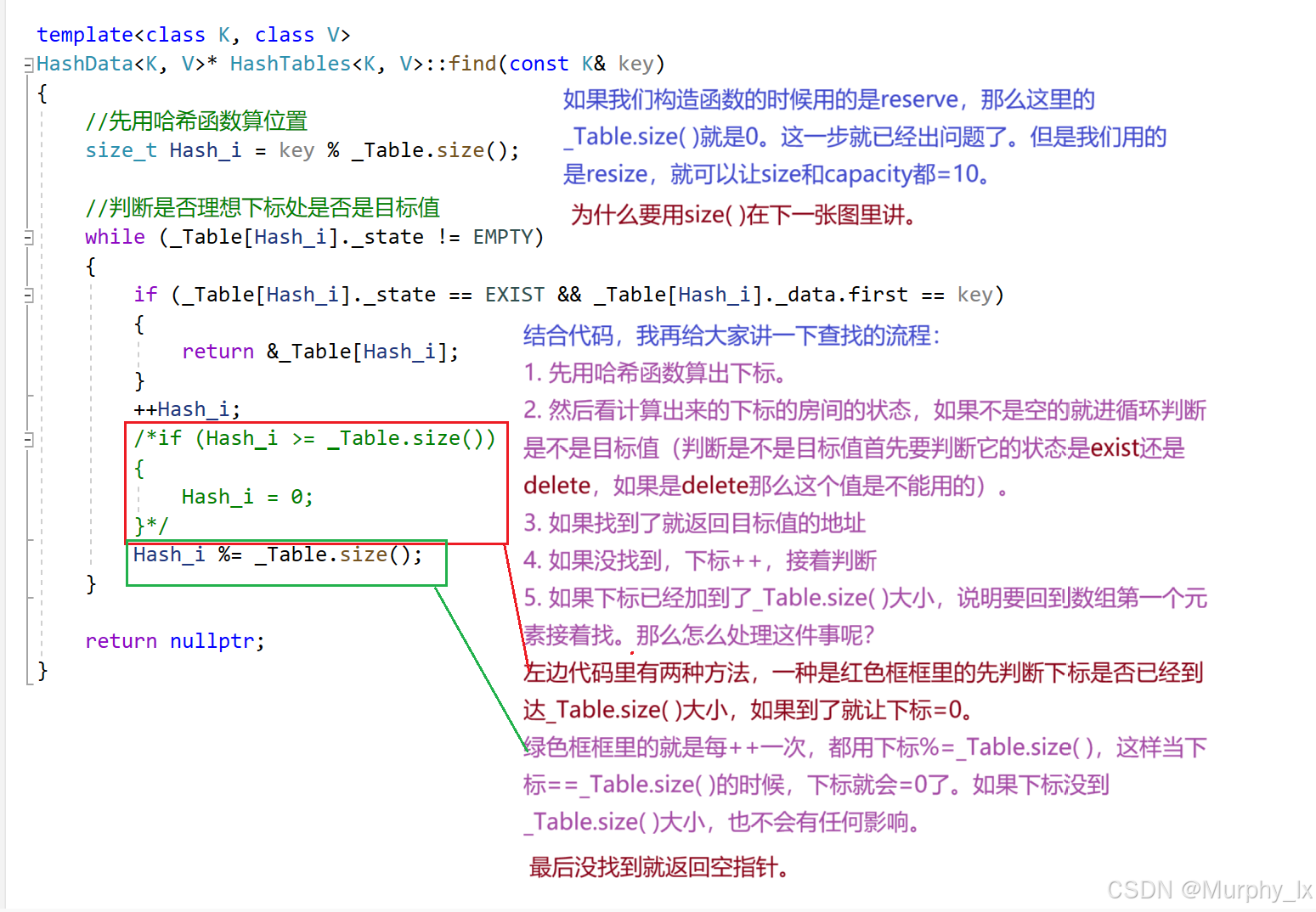
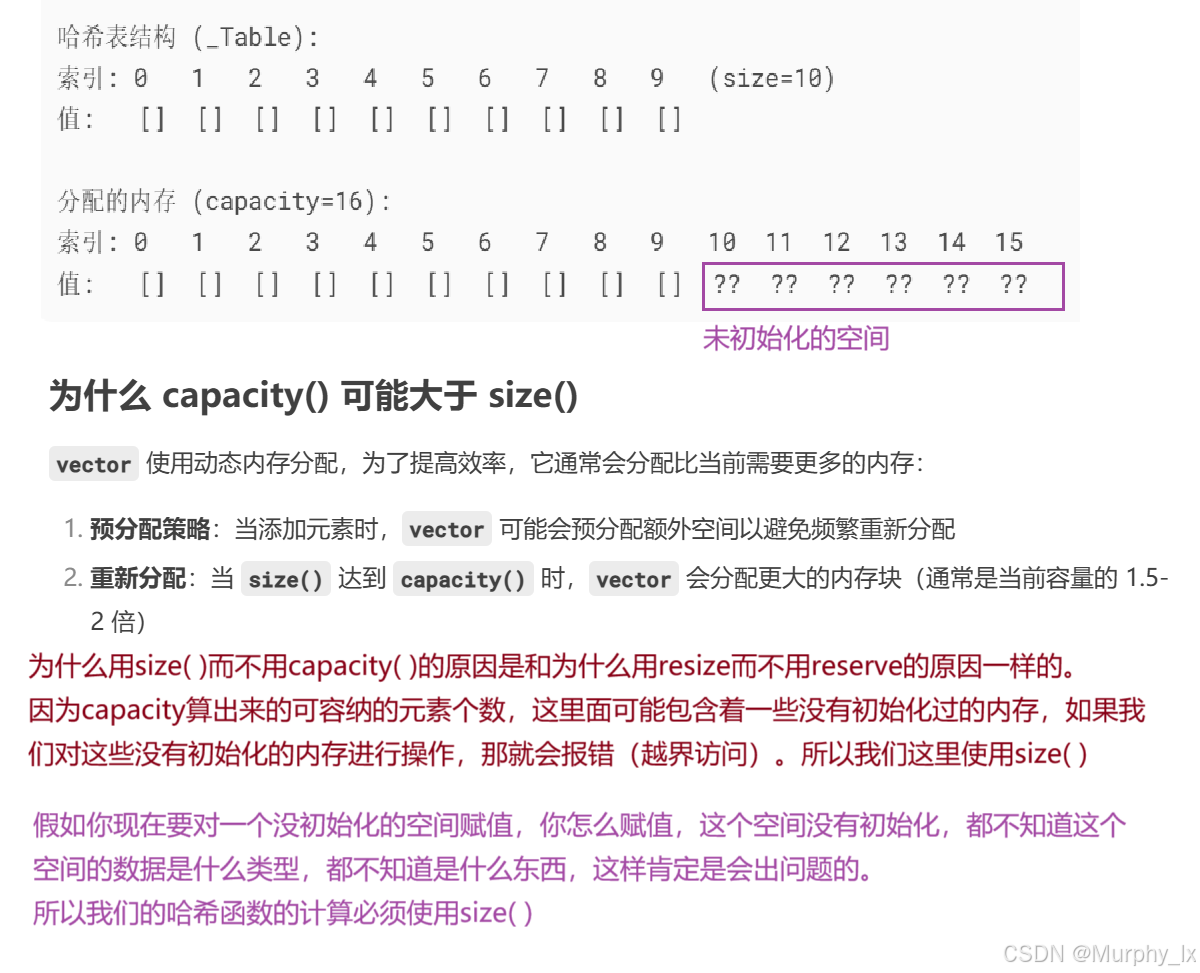
大家也可以用下面这段代码感受一下,什么是size( )和capacity( )会不相同,大家观察t1和t2这两个值的变化:
#include<vector>
int main()
{
vector<int> v1;
size_t t1 = v1.size();
size_t t2 = v1.capacity();
v1.resize(4);
t1 = v1.size();
t2 = v1.capacity();
v1.push_back(1);
t1 = v1.size();
t2 = v1.capacity();
v1.push_back(2);
t1 = v1.size();
t2 = v1.capacity();
v1.push_back(3);
t1 = v1.size();
t2 = v1.capacity();
v1.push_back(4);
v1.resize(2);
t1 = v1.size();
t2 = v1.capacity();
return 0;
}
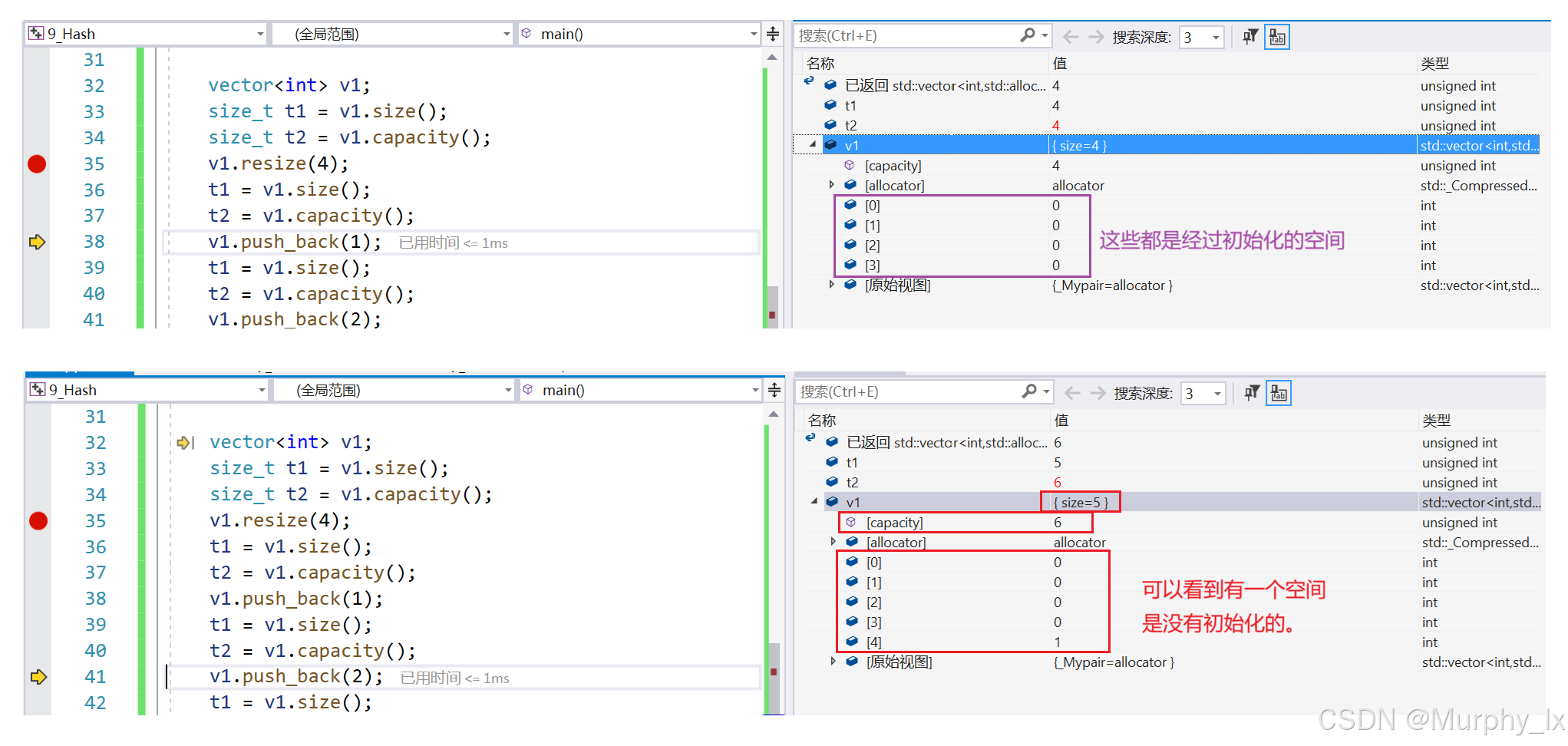

- 插入
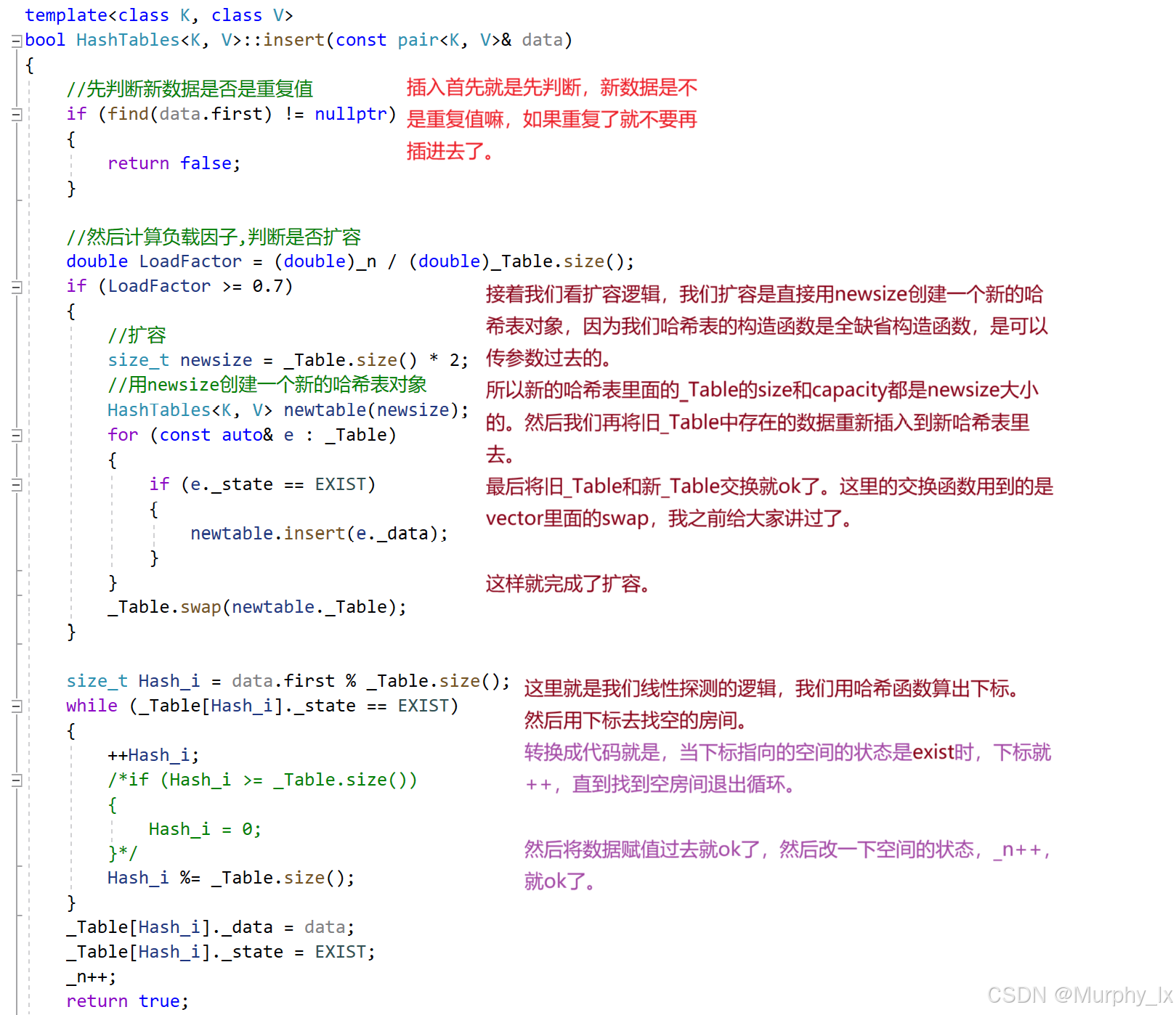
- 删除
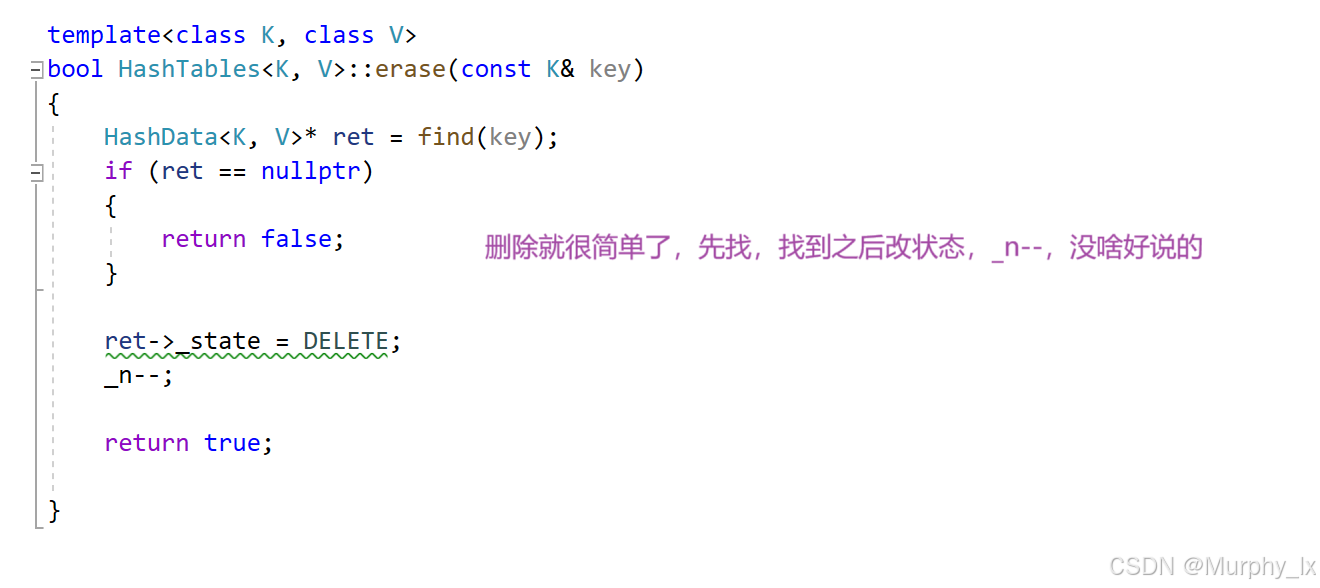
完善
虽然我们这个方法下的哈希表已经写的差不多了,但是还有一个很重要的问题没解决。如果我的Key是string类型的数据,我怎么计算理想下标位置?如果我的Key是自定义类型,我该怎么计算理想下标位置?
那该怎么解决呢,大家往下看:
Hash.h
#pragma once
#include<iostream>
#include<cassert>
#include<utility>
#include<vector>
using namespace std;
enum State
{
EMPTY,
EXIST,
DELETE
};
template<class K, class V>
struct HashData
{
pair<K, V> _data;
State _state = EMPTY;
};
template<class K>
struct HashFunc
{
size_t operator()(const K& key)
{
return size_t(key);
}
};
//模版特化,当数据类型是string类型的时候,会直接用写好了的这个
//讲模版的时候讲过了:如果有现成的,就用现成的.
template<>
struct HashFunc<string>
{
size_t operator()(const string& s)
{
size_t hash = 0;
for (auto e : s)
{
hash += e;//这里是 + e的Ascll码
hash *= 13;
}
return hash;
}
};
template<class K, class V, class Hash = HashFunc<K>>
class HashTables
{
public:
HashTables(size_t size = 10)
{
_Table.resize(size);
}
HashData<K, V>* find(const K& key);
bool insert(const pair<K, V>& data);
bool erase(const K& key);
private:
vector<HashData<K, V>> _Table;
size_t _n = 0;//存储已有数据个数
};
template<class K, class V, class Hash>
HashData<K, V>* HashTables<K, V, Hash>::find(const K& key)
{
Hash hs;//仿函数对象,用来调整key的,让key的类型变为为size_t
//先用哈希函数算位置
size_t Hash_i = hs(key) % _Table.size();
//判断是否理想下标处是否是目标值
while (_Table[Hash_i]._state != EMPTY)
{
if (_Table[Hash_i]._state == EXIST && _Table[Hash_i]._data.first == key)
{
return &_Table[Hash_i];
}
++Hash_i;
/*if (Hash_i >= _Table.size())
{
Hash_i = 0;
}*/
Hash_i %= _Table.size();
}
return nullptr;
}
template<class K, class V, class Hash>
bool HashTables<K, V, Hash>::insert(const pair<K, V>& data)
{
//先判断新数据是否是重复值
if (find(data.first) != nullptr)
{
return false;
}
//然后计算负载因子,判断是否扩容
double LoadFactor = (double)_n / (double)_Table.size();
if (LoadFactor >= 0.7)
{
//扩容
size_t newsize = _Table.size() * 2;
//用newsize创建一个新的哈希表对象
HashTables<K, V> newtable(newsize);
for (const auto& e : _Table)
{
if (e._state == EXIST)
{
newtable.insert(e._data);
}
}
_Table.swap(newtable._Table);
}
Hash hs;//仿函数对象
size_t Hash_i = hs(data.first) % _Table.size();
while (_Table[Hash_i]._state == EXIST)
{
++Hash_i;
/*if (Hash_i >= _Table.size())
{
Hash_i = 0;
}*/
Hash_i %= _Table.size();
}
_Table[Hash_i]._data = data;
_Table[Hash_i]._state = EXIST;
_n++;
return true;
}
template<class K, class V, class Hash>
bool HashTables<K, V, Hash>::erase(const K& key)
{
HashData<K, V>* ret = find(key);
if (ret == nullptr)
{
return false;
}
ret->_state = DELETE;
_n--;
return true;
}
test.cpp
#include"Hash.h"
void test1()
{
HashTables<int, int> ht;
ht.insert(make_pair(23, 1));
ht.insert(make_pair(45, 1));
ht.insert(make_pair(78, 1));
ht.insert(make_pair(12, 1));
ht.insert(make_pair(67, 1));
ht.insert(make_pair(89, 1));
ht.insert(make_pair(3, 1));
ht.insert(make_pair(56, 1));
ht.insert(make_pair(92, 1));
ht.insert(make_pair(19, 1));
ht.erase(23);
//ht.insert(make_pair(43,1));
HashData<int, int>* rt = ht.find(3);
ht.erase(45);
ht.erase(78);
}
void test2()
{
HashTables<string, string, HashFunc<string>> ht;
ht.insert(make_pair("apple", "苹果"));
ht.insert(make_pair("sort","排序"));
ht.insert(make_pair("black","黑色"));
ht.insert(make_pair("hello","你好"));
ht.erase("apple");
}
int main()
{
test2();
return 0;
}
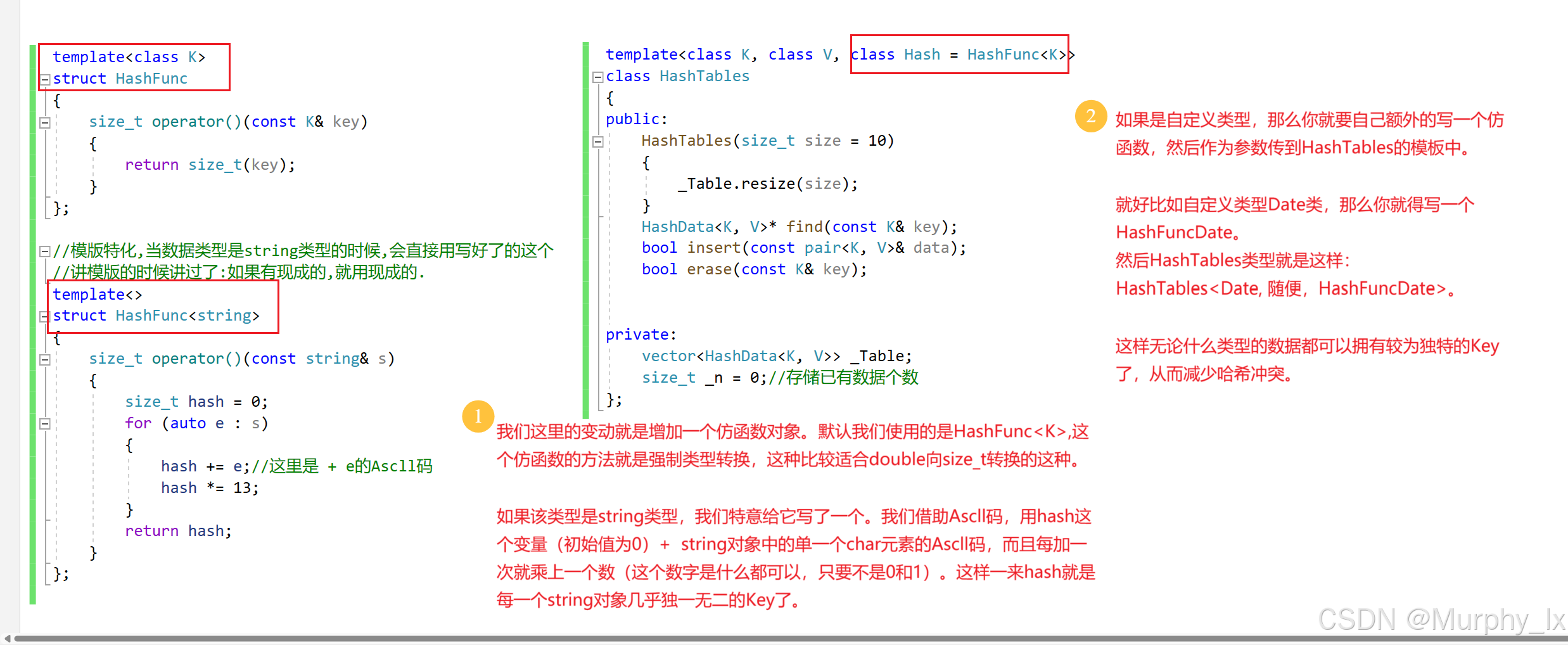
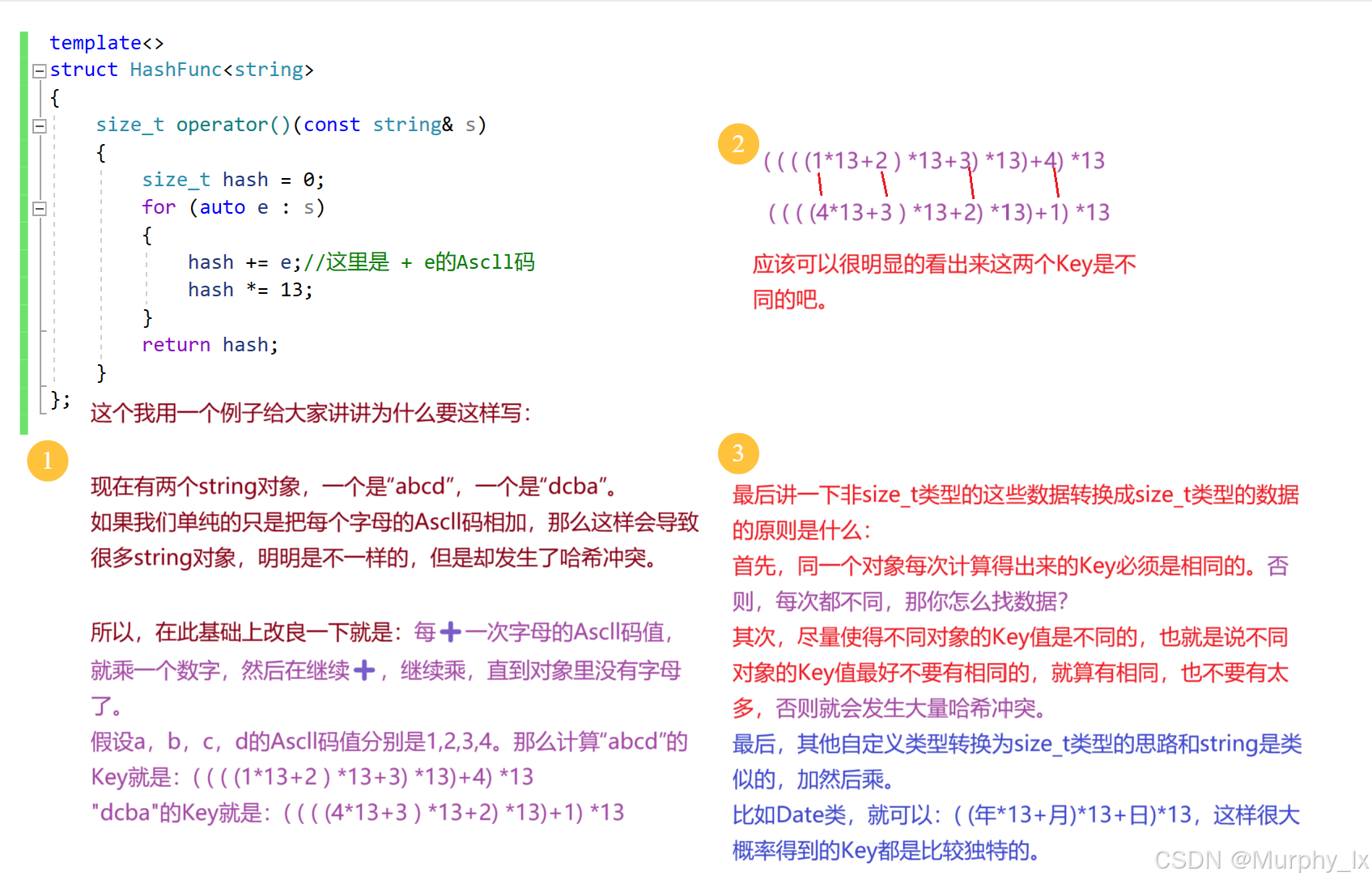
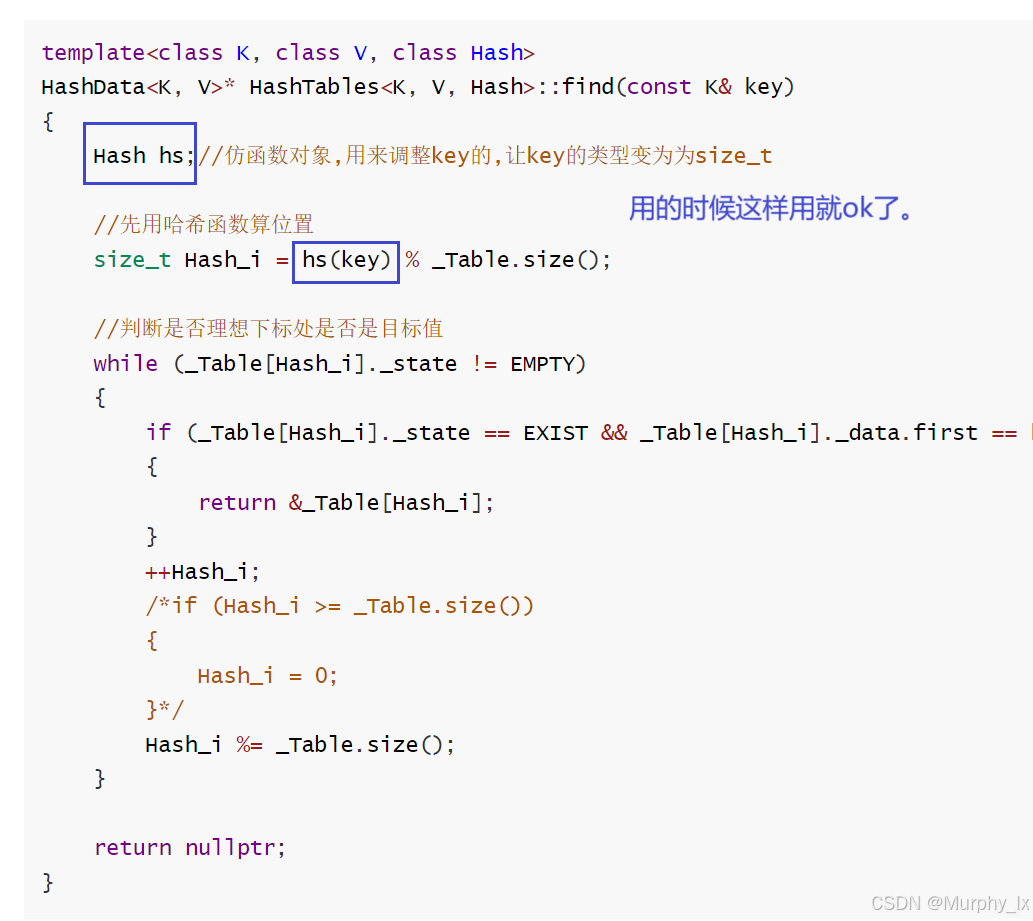
这就是闭散列比较完整的展示了,开散列在下一节,这节已经很长了。